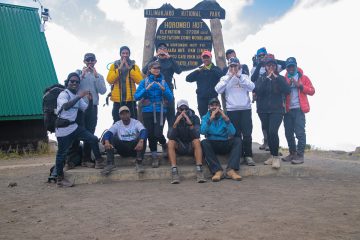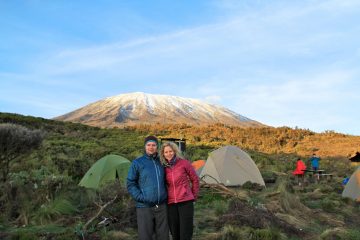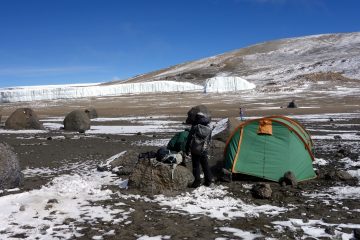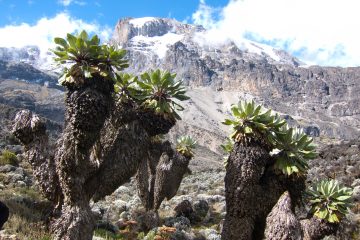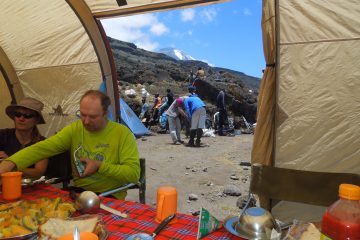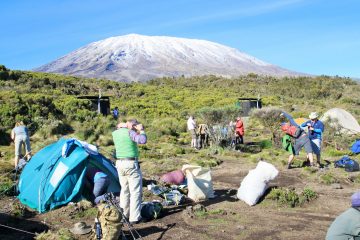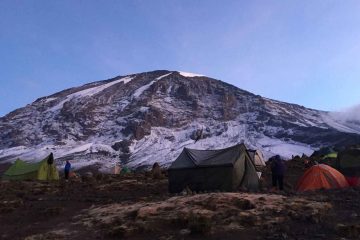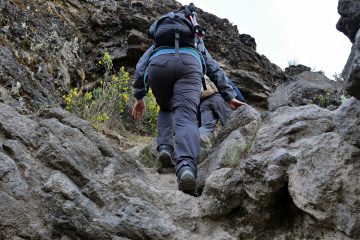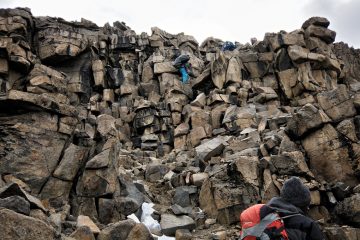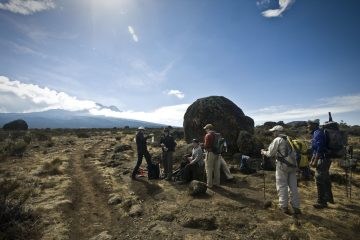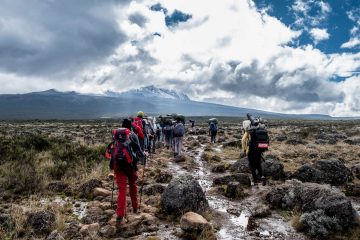Many wild animals species live around Mount Kilimanjaro, in abundance. Seeing Mount Kilimanjaro’s wildlife while climbing the upper slopes is a matter of sheer luck as wildlife is elusive on the mountain. The lower slopes and the area surrounding the mountain, including the Kilimanjaro National park area are filled with a variety of wild animals. Mount Kilimanjaro has one of the most exotic fauna you could find in the whole of Tanzania. Wildlife usually avoids people and judging by the fact that Mount Kilimanjaro receives thousands of mountain climbers throughout the year following specific trails leading to the summit of the mountain. This means that since wildlife on mount Kilimanjaro tends to isolate themselves from humans, you will virtually see no animal worth writing home about, however, you might be the lucky one, so keep your eyes open at all times.
You might have probably seen those amazing pictures of elephants and giraffes with the backdrop of Mount Kilimanjaro at the back, those were obviously taken from the other side of Mount Kilimanjaro, on the Kenyan side at the Amboseli national park
Amboseli lies at the base of Mount Kilimanjaro, heading to the north of the mountain. If you climb Kilimanjaro on the Rongai route which lies near the border of Kenya and Tanzania, you may get lucky, as very few times some of the wildlife moves near Kilimanjaro.
If you want to see plenty of wildlife and climb a mountain at the same time, Mount Meru is the better option as it is located right inside the Arusha National Park
What animals can you see on Mount Kilimanjaro?
Due to easier access to food and water, more animals can be found in the lush tropical rainforests near the foot of Kilimanjaro than in the highlands. There will be fewer animals nearby as your troop ascends higher. Any animals seen on Mount Kilimanjaro are unquestionably “wild” because all animals in Tanzania’s national parks are allowed to roam freely. Thankfully, during your climb, your squad won’t come across any lions or other hazardous creatures. During your ascent, you are more likely to observe the Abbott’s Duiker, a shy type of antelope, or babbling monkeys. Here are eight of our top wildlife sightings from Kilimanjaro.
The Black & White Colobus Monkey
The black and white colobus monkey is a native of Tanzania, where it inhabits the tallest trees in family groupings.
If you spot one colobus monkey, there are often siblings hiding in a neighbouring tree. Be on the lookout for these monkeys’ distinctive long black-and-white tail and loud chattering sound.
You should snap lots of pictures of these unique monkeys without disturbing them since colobus monkeys are considered “guereza primates” and the ones on Mount Kilimanjaro are an endangered species.
More about the black and white colobus monkeys
Aardvark
Only in Sub-Saharan Africa can one find this unusual and fascinating species. Despite the fact that they resemble pigs somewhat (and that their name comes from the Afrikaans word for “ground pig”), they are really connected to one of my favorite African mammals: the elephant! Even if the large ears and long snout are not exactly like those of an elephant, we won’t contest science.
Serval Cat
While lions and leopards receive most of the media attention, Tanzania is also home to a number of other ‘big cats’. The serval cat is a wild cat with coloration that resembles a cheetah but is smaller and more slender than its relative.
The serval cat has the longest legs in relation to the rest of its body. It also has big ears and a black body pattern with spots and stripes.
The only time people see this lone cat is when it is out hunting. It is active day and night. Serval cats consume almost everything, including grass, antelope, wild rabbits, insects, and reptiles, in addition to tiny rodents.
During your ascent of Kilimanjaro, if your hiking group is peaceful, you could be fortunate enough to see a serval cat. See also about the Civet
Tree Hyrax
The little, agile tree hyrax is another species that may be seen on Mount Kilimanjaro and is strangely connected to the powerful elephant. In wooded locations, where they—you got it—live among the trees, tree hyraxes may be found. These creatures have a natural home in the lower woods of Kilimanjaro.
Tree hyrax produce a unique “call” in the early evening and at night, so you can hear one before you see it. Be not afraid; the tree hyrax may simply be identifying its territory as the sounds range from a giggle to a loud screech.
You must pay great attention after nightfall in order to see these unique animals. Because they are nocturnal, aardvarks stay out of the sun’s heat throughout the day. They emerge at night when it is cooler and eat termites and ants. They have been observed travelling great distances in search of a nice termite mound to feast on, reaching the small insects with their long snouts. More about the Tree hyrax.
Duiker
The term “duiker” is derived from the Dutch verb “to dive,” which aptly depicts this animal’s plunge into the bushes to elude predators. Duikers are a kind of antelope.
The duiker is smaller than a typical grassland antelope and has horns that are distinct shapes in addition to having a hump on its back. You are unlikely to see duikers on a conventional safari in savannah because they live in thickly forested locations. Tanzania’s native duikers can be observed in their natural environment on the Kilimanjaro mountains.
The Abbott’s Duiker is a tiny, critically endangered species of duiker that only exists in a few places left in Tanzania; among the uncommon spots to observe these antelope are the Udzungwa Mountains and Mount Kilimanjaro. The most likely reason of the decrease of the Abbott’s Duiker is thought to be the loss of their native habitat and the impact of deforestation on their food rather than predators.
Tanzania’s wildlife is extremely valuable, and an increasing number of species are in danger. Travelers should choose trustworthy tour operators and take into account the steps each one is taking to conserve Tanzania’s most valuable resource. More about the Abbott’s Duiker
White-Tailed Mongoose
The nocturnal animal endemic to Africa, the mongoose, has a body shape similar to that of a weasel. The capacity of mongooses to kill enormous, poisonous snakes, particularly cobras, may be what makes them most well-known, as demonstrated in Rudyard Kipling’s tale The Jungle Book. The white-tailed mongoose is the biggest member of the family of mongooses. For concealment in forested regions, their bodies are often brown in hue. They are called “White-tailed Mongoose” because of their long, white, fluffy tails, which set them apart from other mongooses.
If you chance to observe a mongoose, be careful not to startle it since, like the skunk, it can exude a musky odour when startled.
Did you know that guests at the Aishi Machame Hotel frequently see White-Tailed Mongoose there? Visitors who stay at the luxury hotel get the opportunity to witness some of the rare species that call the mountain home and are really at the foot of Mount Kilimanjaro.
See also about the Thompson Gazelle
Bush Baby
The cutest is saved for last. The woods of Kilimanjaro are home to the endemism Bush Baby, also known as Galagos. This little nocturnal monkey is distinguished by its charming features and large eyes.
During your ascent of Kilimanjaro, you could hear them from your toasty tent. These creatures are most active at night, frequently creating noise and leaping through the woods. The Bush Baby gets its name from the way it sounds, which is much like a baby wailing! Although they are related to monkeys, bush babies don’t exactly resemble other primates in appearance. They are tiny, with soft, fluffy fur in either grey or brown, and have adorable, pointed ears that help them hear at night.
They are indeed adorable, and “Bush Baby” is a moniker that fits these little apes well. More about the Bush Baby.
Jackson’s Chameleon
A species of lizard, chameleons are mostly found in Africa. They are regarded as one of the few species of animals that can alter their skin tone in reaction to emotions, and variations in light, temperature, or humidity.
A chameleon’s eyes can move independently of one another, allowing it to view in two places at once. They can attack and catch insects with incredible accuracy thanks to their unique eyesight and capacity to throw their tongues at speeds of up to twice their body length.
A tiny two-horned chameleon known as the Dwarf Fischer’s chameleon lives on Kilimanjaro, along with the three-horned Jackson’s chameleon.
Marsh Mongoose
The Marsh Mongoose belongs to the same mongoose family. The marsh mongoose is notable despite being smaller than its white-tailed sibling because it is aquatic! This mongoose likes to swim in wetlands. The Marsh Mongoose has a distinctive method of hunting for birds: it will pose as if it is sunbathing and point its belly (and buttocks) upward.
Birds flock to the mongoose to have a closer look at the pink flesh against the fur, and the fast mongoose then captures its prey.
Quiet hikers on the Kilimanjaro have a good chance of spotting this creature. Why? Similar to the Kilimanjaro climbing track, mongooses like to walk on flat surfaces. See also information about the African Leopard.
Blue Monkey
The Kilimanjaro rainforest is home to the Blue Monkey, also known as the Diademed Monkey, which is most prevalent around Big Forest Camp (the first campsite on the Lemosho Route).
The primates aren’t exceptionally blue, thus the moniker is deceptive. With spots of white and black, the body is a gray and olive tint. Their forehead has some yellow or lighter spots, and their face is darker overall. Their eyes have a rusty brown color.
Tall trees that offer both food and shelter are where the blue monkeys spend most of their time. They like to eat figs and fruits, however, they may also consume flowers, leaves, and insects. Read about the Blue Monkeys.
4 Stripped Mouse
Nearly anywhere there are people, there are also rats.
These mice resemble chipmunks in appearance and are a little bigger than house mice. Its back is striped with four black lines.
They are less active throughout the middle of the day than other mice, being more active in the mornings and late afternoons. They are solitary foragers as well, although living in groups.
White-Necked Raven
As your party ascends Mount Kilimanjaro to higher elevations, you may notice a decreasing amount of animals (or indications of wildlife), as the flora dwindles and the environment becomes less hospitable. The White-Necked Raven, however, flourishes at greater elevations.
You can spot this regal-looking blackbird at your high-altitude campsites; it has a collar of white feathers around its neck.
Ravens consume anything, including human food. Because of this, never leave your food out, even if they are in a container, as this intelligent bird has been known to figure out how to open them or simply carry that bag of chips away to devour it at the top of a tree.
Click here to know more about the birds of Mount Kilimanjaro
Elephants of Mount Kilimanjaro
NATURAL HISTORY
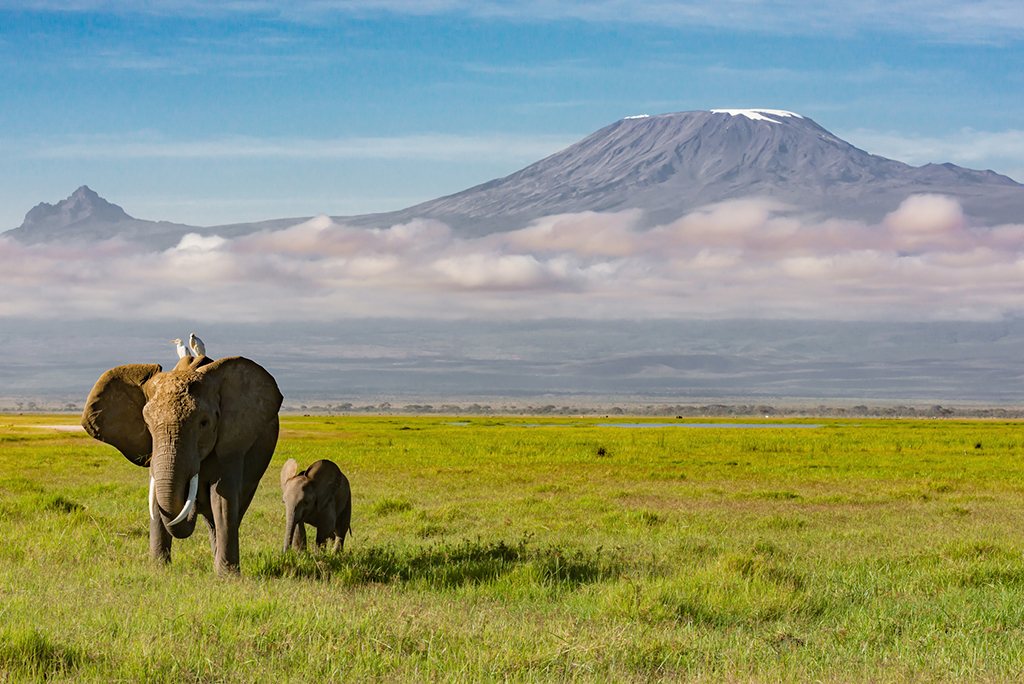
The elephants of Mount Kilimanjaro (Loxodonta Africana) are more famous for posing in front of the snow-capped giant of a mountain. What most people do not know is that Mount Kilimanjaro is found in Tanzania but very much visible on the Kenyan side. Most of these pictures are taken from the Kenyan side of Amboseli national park. Even though there are elephants roaming around the foot slopes of Mount Kilimanjaro and the Kilimanjaro national park, spotting them is not an easy task. The largest and most exciting of all the animals that live on and around Mount Kilimanjaro is the elephant.
Some years back, these gentle giants used to roam freely around Mount Kilimanjaro but when humans invaded the mountains for cultivation they migrated to the Kenyan side and some were poached or killed due to human-animal conflict.
When tempted by the succulent crops, especially on the West Kilimanjaro side, elephants and monkeys face poisonous traps, snares and spears.
The Buffaloes of Mount Kilimanjaro
The lower rainforest of Mount Kilimanjaro is home to many animals including the African buffalo (Syncerus caffer) also known by another name: the Cape buffalo is a large mammal that resides in the mountain’s rainforest vegetation zone and the Kilimanjaro National Park.
There is a well-preserved buffalo carcass along the Rongai route.
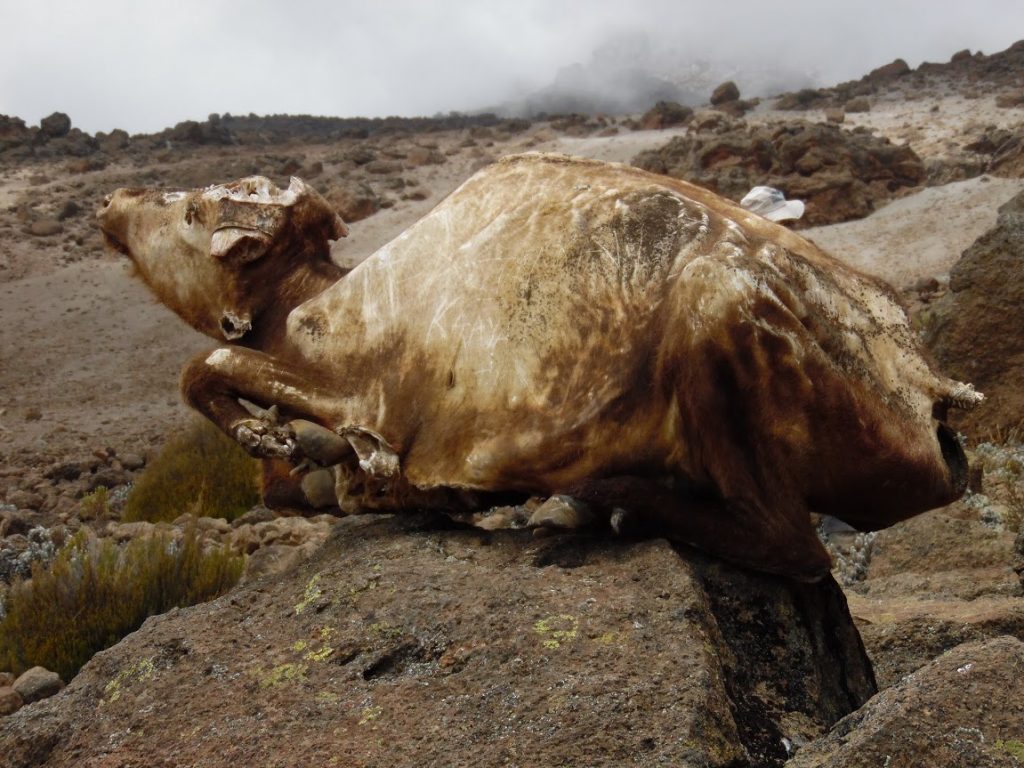 By dietary classification, buffalos are herbivorous and very successful grazers that are found in different habitats like swamps, floodplains, and forests, open and wooded savannahs and also in mopane grasslands.
By dietary classification, buffalos are herbivorous and very successful grazers that are found in different habitats like swamps, floodplains, and forests, open and wooded savannahs and also in mopane grasslands.
On Mount Kilimanjaro, buffalos are found at the base of the Mountain with large populations residing in the Amboseli National Park on the Kenyan side.
Buffalos of Mount Kilimanjaro usually graze in the early mornings and late evenings and they prefer to look for thick cover like the dense rainforest region of the mountain during day time when it is hot.
The Kilimanjaro Giraffe
The Kilimanjaro giraffe, otherwise known as the Maasai giraffe is a beautiful species that is not only the largest giraffe in the world but also the tallest animal in the world.
In the Kilimanjaro region, giraffes are found on both sides of the Mountain, Amboseli in Kenya and Kilimanjaro National Park in Tanzania.
The Kilimanjaro giraffe is distinguished by more jagged spots, the design of its fur “stamped” with irregular patches, which are darker in males, but generally brown with several shades of such colour in females.
 ADDITIONAL ANIMAL SIGHTINGS NEAR KILIMANJARO
ADDITIONAL ANIMAL SIGHTINGS NEAR KILIMANJARO
There is a better chance of spotting wild animals when you are using the Rongai route than any other, this is because the Rongai Route passes close to the Kenya – Tanzania border. Just nearby the Rongai Route is the Amboseli National Park, which has plenty of elephants, giraffes and other big game animals.
There have been a few sightings of Lions on the Shira Route but it is extremely rare that it is hard to believe.
Most of the big game wild animals are found in the lower altitudes, especially in the Rainforest vegetation zones where food is plenty and rainfall is frequent. Still, sightings are not easy to come by as these forests are very dense but they are the home of some of the big game animals like elephants, giraffes, buffalos, leopards, etc.
In conclusion, since animals are scarce on Mount Kilimanjaro and if you are interested in seeing more animals, a safari and Kilimanjaro packages can be arranged. Even better, you can pick some of our ready-made Mount Kilimanjaro and wildlife safari itineraries below.


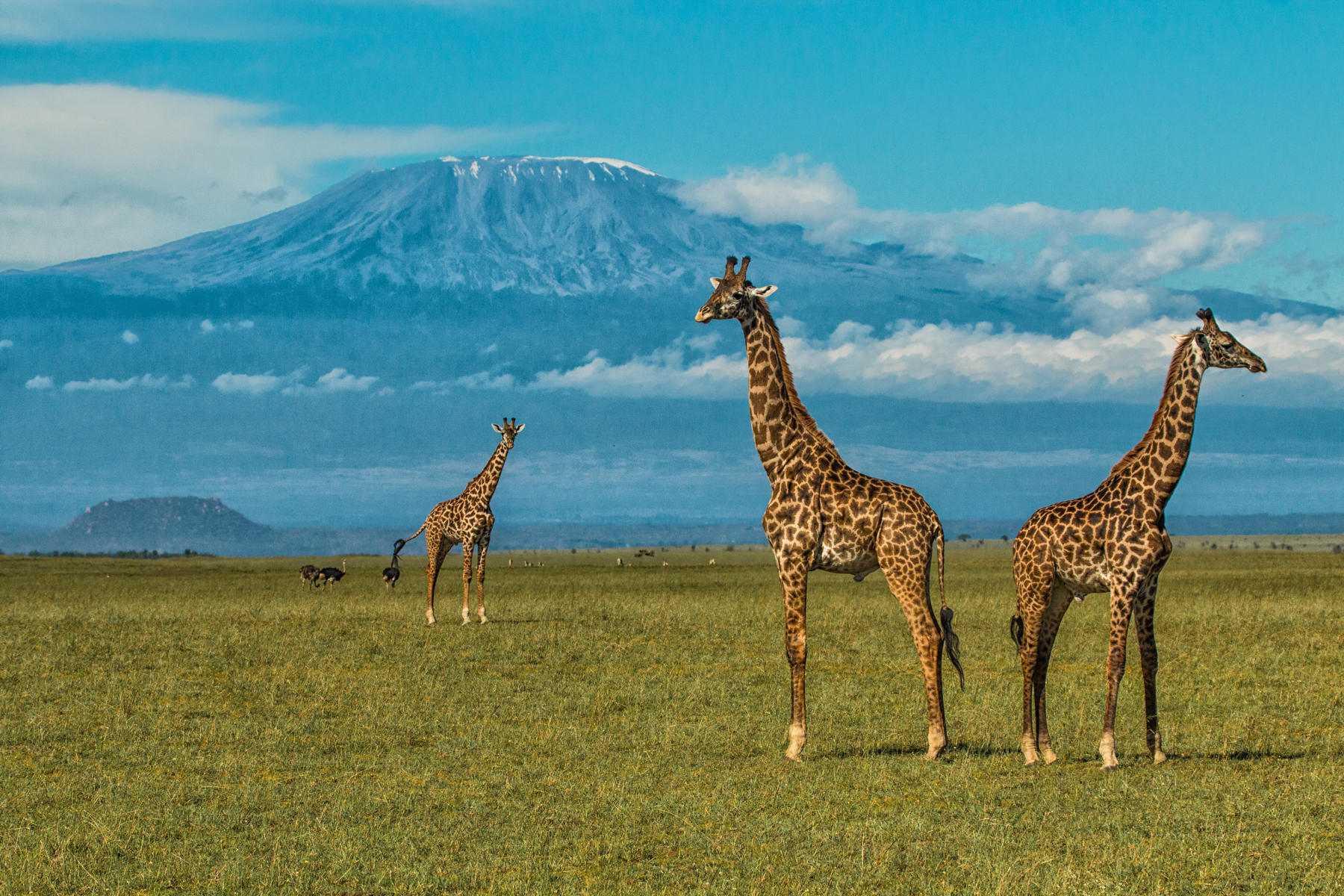 ADDITIONAL ANIMAL SIGHTINGS NEAR KILIMANJARO
ADDITIONAL ANIMAL SIGHTINGS NEAR KILIMANJARO

